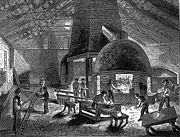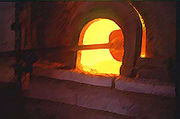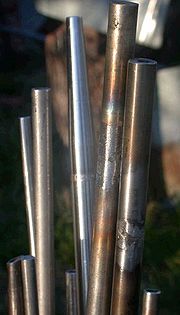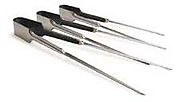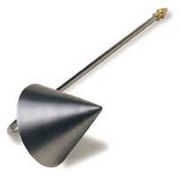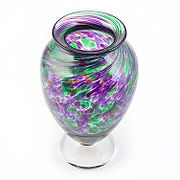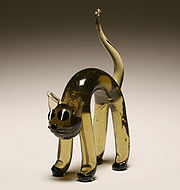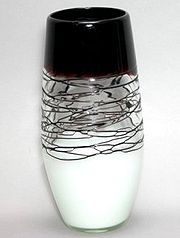Glassworking
From Mizahar Lore
Glassworking is the main skill of a glass smith. The smith can create lenses, mirrors, dishware, small toys/art pieces, and windows all from his use and knowledge of glassworking. In most cities glass is for the rich and powerful. Gold and silks can be draped about by any fool, but glass is for those who can spend money. Glass is also sought after by philterers, glass is vastly superior to any clay jug or vial, for philterers quickly found out that glass can be cleaned and reused, while clay not only sometimes soaks up their precious concoctions, or changes the substance within. Furthermore, magecrafters use glass not just for their use of lenses and mirrors, but also as a reagent. Glass allows energies to pass through it and if etched with glyphs, can act as a type of filter. Most glassworkers, located in large cities, will setup trades with local magecrafters and philters so that both can benefit from supplies and specialized tools.
Even though glass is widely sought after for its many uses, it still remains a rare commodity. Just by its very nature glass does not travel well - so most glass smiths sale their wares in the city where they produced them. The most notable exception of this rule is the fabled glasswares of Wind Reach. Merchants have dared the climb and hazards of the journey to return with but a handful of items to show for it… but as the dangers killed the brave and foolish, the trade routes to Wind Reach have all but become legend.
Contents |
History
Pre-Valterrian
It was said that when Priskil and Aquiras joined on the heavenly plain, Priskil would weave glass from light and give it to her lover so that he would remember her whenever he had to leave. As Aquiras journeyed the land, he saw young couples marry, and if their love inspired the God, he would leave a glass token given by Priskil to him upon their doorstep. Motivated deeply by Aquiras' gesture, Priskil talked to Isur to make the tools necessary for mortals to weave glass. Isur nodded and forged tools to weave the very light into sand. Upon completion Priskil peered through her glass gifts seeing all of the couples Aquiras had judged. Priskil chose a couple that just had their fifth child and still loved one another like they did the day they married, and she gave them the tools and showed them how to craft glass from sand, so that it would always hold love in. As time passed, the family grew and shared their knowledge with those who wished to learn it. Eventually, it became a common gesture to place a piece of glass at the foot of the newlywed couple’s doorstep during the wedding night. If the glass ever broke then it was said that their love would break as well.
As the craft grew, glassworkers became hailed as grand artists. Masters of the craft were called upon by merchants to spin grand pieces, churches asked for colorful stained glass windows as tall as five men, nobility asked mirrors for their wives and mistresses, and scholars asked for glass panes to squeeze old pages of text and seal them from the air. When the Valterrian happened nearly every piece of worked glass was destroyed, and since glassworking wasn’t a skill needed to survive the new world, the skill lost most of its lore.
Post-Valterrian
Glassworking would probably be lost if not for the simple gesture of leaving a small piece of glass at the foot of the newlywed’s doorstep. Some apprentices who had survived the disaster and provided small works of glass here and there for people. As time went on, bottles and jars were made to preserve food and drink. It has taken hundreds of years for people to become interested in glasswares beyond vessels for liquid, and a glassblower can craft something more than a container. The cataclysm destroyed the knowledge base of the skill and even masters of the craft pale in comparison to those of old. For the few craftsmen who have seen glass from Wind Reach, they have realized that some of the old techniques have survived in the city… and if anyone should ever bring back their ancient techniques they could be very rich indeed.
Prerequisites and Maintenance
Almost all glassworkers learn their trade from another Glassworker; this is mainly due to the expensive equipment and knowledge of the materials needed to craft anything of value. If someone was to venture into the craft with nothing else then reading a book, they could spend years just figuring out what type of sand to use and at what temperature is needed to make clear glass. It is far better to seek out a Glassworker and work in their hot shop till one can make enough money to purchase their own equipment. As a glassworker grows in skill, learning philtering and metalsmithing would help them create tools and different colored glasses.
Of course, most of a glass smiths tools are created by a blacksmith or a carver. While metalsmithing would help the smiths craft clearer mirrors by pouring low temperature metals onto the back of a glass pane, metalsmithing also creates the expensive iron casting molds for glassworkers. Carving can produce dense molds made of wood that can be used less often as the iron ones, but cost a great deal less to procure. Using molds, apprentices can craft as many as forty items a day instead of sixteen or so. Gold or tinsmithing can allow the glassworker to set their pieces in metal without cracking it. The smith merely heats up the metal and places glass into the piece, when the metal cools down, it shrinks around the glass and prevents it from moving. However, if the glassworker is not careful the piece will shatter under the stress.
Learning philtering has a double benefit for the glassworker. Philtering teaches the glassworker not only to purify his ingredients and how to make them different colors, but as the glassworker learns philtering, they finally see what their craft is used for. Knowing why a vial or flask must be shaped a certain way makes the glassworker able to better craft the item for its intended use. Etching is also helpful for the glass smith, while other glassworkers etch their mark in the glass to spread their fame.
The Hot Shop
A glassworker’s work area is often called the hot shop, due to the extreme heat in the workshop from several ovens. It is not unheard of to see water steaming from the heat of the shop in the middle of the summer. Therefore most Glassworkers will have large shops and several vents in the ceiling to allow the excess heat to escape. The second feature is a large stone table and the third is an annealer outside of the room.
The Batch Oven
The batch oven is the first oven that the glassworker will start from. The oven has a pit where coal can be shoveled into to it to keep the extreme heat going. Much like a forge, a bellows will be connected to the pit to make sure air gets to the fire. Above the pit is the crucible, which is a large pot that contains the molten glass. Since it takes several days for the glass to melt and release all of its trapped air the crucible is usually a large iron smelting pot. Doors that contain a small hole to look down into the pot and allow blowing pipes to enter are commonly used. The oven will have a rectangle shaped hole to allow glass blowing pipes to heat up the ends before use; this is usually set in the side to allow easier access for Glassworker. The last feature of the oven is the small exhaust pipe to the roof that allows the coal fumes to leave.
Large glassworking operations will have grates upon which coals can burn, the ash drops down into the pit and workers can keep the oven clean while never allowing the oven to cool. With such setups the oven will contain several crucibles with different batches in them, allowing glassworkers to have several varieties of glass when they desire. These types of ovens are very costly and are only found in major cities like Syrliras or Sultros. Wind Reach have their ovens opened to the molten magma streams below the mountain and use heavy iron grates to set their crucibles on, making the cost of glass almost nothing for them.
The Glory Hole or The Drum Oven
The glory hole is a second oven, however, instead of being open to the pit of coals, the oven allows for heated air to move around the drum shape, heating the stones to an even heat for the shaping process. The glory hole contains several hinged doors with circles of varying sizes, the different sized holes are there so that glassworker can place different shapes back into the oven for reheating. In front of the glory hole, there is a metal yoke that allows the blow pipe to rest, while the glassworker spins the pipe to keep the glass from deforming to one side.
The Garage or Holder
The garage is a third oven where half finished pieces can be kept waiting for the rest of the components to be completed. The garage is commonly used when fusing two glass pieces together. For example, the glassworker will create one glass piece of one color and place it in the garage, and then they will craft another piece from a different colored batch. Once the second piece is crafted, they will use a flame torch to melt a point where the first piece will be attached. This technique is called glass fusing and should not be confused with the multicolored pieces that Wind Reach can create.
The Marver
The marver is simply a large marble stab that has its surface ground smooth. Though stone is the more common choice, metal has been used when hard stone is not available. It is located near water barrels and the glassworkers tools. The stab offers a great cold surface to shape the glass as well as a nice work table for tools to be placed near the metal bench for rolling.
The Bench
The bench allows the blow pipe to sit on two metal saw horses, while the glassworker continues spinning the blow pipe. While the blow pipe is spinning the glassworker can sit down and use jacks, paddles and shears on the gathered slug of glass to shape his creation.
Molds
Molds can craft glass pieces in the matter of minutes, and since the material of the mold is cool enough to anneal the glass, it can be poured in and then placed into the annealer right afterward. Anything from bottles to glass panels can be placed in a mold. Molds usually contain two side pieces and a ring cap to shape the top. The detail of the mold depends on the carver or metalsmith one can find. Wood molds may be used, but they must be dunked into water for at least several hours before use. Metal molds are the most sought, due to the durability and the ease in which the glass comes off of cold metal. A specific mold for casting glass panels is called a glass cast, and most glassworking shops will have one.
The Break Box
The break box is a cradle that is filled with cloth and wool. Once the glassworker is done with his piece he will take it over to the break box. He will then break the piece of the blow pipe or punty into the break box. The cloth will cushion the impact of the piece, making sure it doesn’t break. The box is only used if the piece was hand blown, as had the glassworker used molds, then this should not be necessary.
The Annealer
The annealer is the last oven the piece is placed in. Due to the amazing amount of heat still inside the glass, it is important to slowly bring down the internal temperature of the piece. Usually a glass smith will keep the annealer roughly one-half the temperature of the batch oven. Once they have accumulated enough pieces, the glass smith will slowly bring the temperature of the annealer down to room temperature. The longer this process takes, the less likely it is that cracks will form in the finished product.
Tools
Mentioned above were the major pieces of equipment found in a glassworker’s hot shop. Below are some of the more common tools of the trade.
Blow Pipes
The blow pipe isn’t a complex tool - it usually has a diameter inch to one and one quarter inch. The most commonly used blow pipes are four feet in length. However, pipes can come longer or shorter based on the needs of glassworker. The shorter the pipe, the less distance between the molten glass and the glassworker’s hands, the longer the pipe the glassworker will have to work with several others to shape and mold the glass. However, because the glassworker is working as part of a team, they usually can support a greater volume of glass.
Jacks
Though jacks are nothing more than large plithering tweezers, they play an important role in glassworking. Many glassworkers will use the points of their jacks to create contours in the glass or to start creating an indent in the glass for it to sit better. The circular end can be used as a straight edge to smooth out features on the glass.
Paddles
Paddles are used to help create a large straight line on the rotating glass surface. Paddles are useful because in the place of a large stone table, they can be used as a quick marver.
Leather
The glassworker will use a heavy cushion of leather to put hand pressure on the glass and create a highly polished surface. Since the leather is controlled by hand pressure, it can push the glass to one side or another, while providing protection for the glassworker. While working with leather and molten glass, the leather burns which gives off smoke and ash, during the crafting.
Ladles
Though ladles can be used to scoop up molten glass from the batch, and then poured into a mold. Ladles, which are also known as blocks, are also used to shape the slug of glass on a blow pipe into a ball or oval in the early stages of the process. Ladles are often made from metal, but have been known to be made of dense wood for the shaping process.
Puffer or Soffieta
A puffer is used to create the opening for a vase or cup. The cone tip starts spreading the glass apart as the glassworker blows in the other end forming a hole. At that point the glassworker can use his jacks to widen the hole and form the open end of the piece.
Shears
Shears are used in cutting molten glass off of the slug that the glassblower has formed. Sometimes a glassworker will remove a slug of molten glass with a tail from the batch, even with the spinning of the blow pipe, the tail will form an ugly non-uniform shell. To save the rest of the piece, using a combination of jacks and shears, they will cut the offending bit of glass and throw it in a waste barrel. Shears are also useful in making handles for vases and cups. A slug of glass will be pulled from the batch and instead of trying to spin the slug into a piece, the glassworker will pull a large cylinder of glass and cut it from the slug to form a handle.
Diamond Tip Cutter
The diamond tip cutter is a small metal rod with a sharp pointed tip created by a metalsmith. The end of the rod was heated to the point of almost melting, and then the metalsmith used diamond dust to embed it in the tip. The glassworker uses the cutter to create defined scratches on the surface of the glass so that when stress is applied to the piece it will break along that line. An alternative to the diamond tip cutter is a magecrafted harden scalpel. The scalpel’s edge is magecrafted to be sharper than any grinding stone and hardened once so that it will not go dull during use. In the long run the scalpel will save money for the glassworker since it will not be replaced like the diamond tip cutter.
Punties
Punties, or bridges (as translated from the old language), are used to transfer the piece to another rod. The punty will usually have a small hardened slug of glass on it to help adhere and then break off the piece. It’s important that the temperatures of the glass of the punty and the piece be at different temperatures. Though the glass will began to fuse, the large temperature difference will form cracks that can easily separate when the piece is cooled. Finding the right temperature to keep the punty at can be very tricky and new glassworkers will often have their pieces fall off the punty onto the floor, or crack the piece when they go into the break box.
Waste Barrel
Perhaps the one forgiving thing about glassworking is that it doesn’t really generate alot waste. If a glassworker should happen to crack or break his piece, he can simply throw it into the waste barrel and then back into the batch from where it came. As long as the glassworker doesn’t mix different kinds of glass the artisian will never waste their glass, but coal and a time can never be recovered.
Fire Torch
The fire torch is a newly magecrafted tool for glassworking and metalsmithing. The fire torch has fire reimancy infused into the rod to provide an intense small flame for glassworkers to heat small parts of the glass. The fire torch appears to be a copper rod with indented glyphs in it. On one end it is bent and produces the blue flame, the other has an adjustable golden ring that can turn. As the ring turns, the intensity of the flames increases or turns off. This is due to the lining up of the enhanced aura with the glyphs crafted on it. Glassworker apprentices have been known to turn the heat so high on the torch that it surpasses the magecrafted hardening and melts.
Different Types of Glass
Just as there are different metals alloys, there are different types of glass, and the type depends on the purity of the materials used in the batch. Although any kind of sand can be used in making glass, most local sands will contain high impurities within. A novice philterer can be employed to refine the sand into a clearer medium, but no matter how good the philterer, the glass will be slightly cloudy and colored. The milky white of glass comes from salt impurities in the sand. While the colored part comes from local minerals in the ground, sadly it usually leads to a brownish or black color instead of anything nice.
For those that are crafting clear glass; soda-lime, often mistaken as white sand, is used. Soda-lime can be found near dried lake beds, or mined from stone pockets. A fish within the Twin Lakes of Wind Reach each local moss and digests it into soda-lime, where they get just about all of their supplies from. Soda-lime is an almost pure white looking powder, and prior to mixing into the batch the Glassworker should consider if they wish to add minerals for color. Below are some compounds made from a competent Metalsmith and their colors. In the instance of black and white, the color is a pure white instead of the swirls and murky color found in natural sand.
Wind Reach’s philterers have found out how to make multicolored glass.
They can craft different colored pellets of soda lime, which glassworkers will roll their slugs in the pellets of soda lime melting them into the glass once it’s put into the glory hole. A glassworker will use his/her jacks to pull off a long cord and wrap it around the slug several times before they start blowing, or will use the end of their jack to create swirling lines in the slug. A competent philterer of Wind Reach can create the colored soda lime pellets, and a competent glassworker can have access to them.
Glass Making Techniques
As a novice glassworker starts out they begin on the most simplest of techniques slowly developing them till mastery of the craft. Once they obtain mastery over the basic techniques, they find that each city has unusual flavors and advance techniques for study.
Novice
Glass Molds: This technique is the most simple and least costly for a novice to learn at the head of a master. The mold provides shape and contours that are well beyond the novice’s ability to shape. Either the novice pulls up a batch of glass with a ladle and pours it into the mold or the novice forms a slug of glass at the end of his/her blow pipe place it in the mold, close the mold, and in some cases blow to form internal cavity. The novice learns how to break off the piece of glass from the blowpipe, while still providing worthwhile work.
Free Hand Blown Glass: This is the earliest attempt of a novice to form vases, bottles, or glasses. Usually a competent glassworker will work with the novice showing them how to keep the glass moving, how hard to blow to form a cavity, and how to us jacks, paddles, and leather to shape glass. While learning the novice will spend a great deal of time on the pipe and not the actual piece, yet when they get closer to calling themselves competent they will be allowed to work on their own.
Hot Glass Sculpting: This technique homes the glassworkers skills by allowing them to play with small slugs of glass. Normally, they will form beads, marbles, or small toy like figurines as they develop this technique. Though masters can fuse different colors and fine details a novice is just learning how to pull at the material to create the desired shape.
Bubble Glass: Normally, this is considered an impurity and poor craftsmanship. However some glassworkers have made it an art. Either the glassworker injects air into the glass right before they pull it out of the batch or they use broken glass that contain impurities. The glass will come out with tiny bubbles from the treatment and will possess a speckled nature. Usually, the glassworker must find a niche market for these works.
Competent
Glass Molds: At this level the glassworker oversees novices working on the molds. He/She has enough experience with the molds to help solve problems that the novices are having, and make suggestions on how to improve.
Free Hand Blown Glass: The glassworker is now experience enough to blow vases, glasses, and cups with a speed and accuracy. They will be simple affairs, but no longer does he/she have to worry about lopsided edges.
Hot Glass Sculpting: The competent glassworker will often work with a novice to make larger goods like plates or round panels. However, an expert will call on them to help them form difficult pieces of glass, it is during this time that the glassworker learns more of his/her craft and begins to see how to us the soffieta and shears effectively.
Crackled Glass: The glassworker now knows how to make crackled glass, as they first removed the slug from the oven they quickly shape the general length of the object they wish to form and submerge it into water for a few moments. The extreme heat of the glass and the cool water forms tiny cracks across the surface creating a spider web pattern. Not surprisingly the technique was founded in Kalinor and slowly it was leaked out into the world. Master Symenestrian glassworkers usually make glasses of crackled glass and a spider stem.
Bitwork: The technique is the basic fusion of two different glass pieces. In the experts earliest attempts they will place arms on vases or create long cylinders around the glass piece. Bitwork is used when the main shape and purpose of the piece is done. With help the expert will have another glassworker keep the piece hot while they pull a slug from the batch. Working with jacks and shears the glassworker will shape the slug into the shape they desire and place it on the main piece. The interface between the two glasses will be weak and at create small tiny bubbles.
Monkstone glass: First made in Mura, monkstone glass comes from a low oxygen oven. The Konti glassworkers had problems keeping smoke out of the ovens on the island, so when they added metal powders to the batch to change color they found that the glass wouldn’t change all the metal. The glass that came out of it had small metal flakes suspended throughout the colored glass. Masters of the technique are able to make the glass look to be like fish scales and are only found in Mura.
Expert
Though the expert doesn’t learn many more techniques, he/she are perfecting the ones that they do have. At this point they are working towards crafting a masterwork piece of glass, if they live in Mura, Riverfall, Sahova, or Wind Reach they will be trying to tease the master secrets out of the head glassworkers. Otherwise the practice of bitwork seems to be the most promising technique and fetches the most money.
Akalak glass: Though this technique is based off of bitwork, it requires that the glassworker form the two pieces perfectly. The expert glass blower will form two separate piece of glass from two different batches. Crafting the piece, he/she will create a fuse spot for the glass pieces to join together the skill comes into play because there must be no overlap or depressions that could form an air pocket. Once the glassworker touches the two pieces together they will not be able to adjust them anymore, so two glass blowers must be very careful during this process. This technique allows the glassworker to fuse small sections of two different colored glasses together.
Master
Bitwork: At this point the glassworker has reached the best they ever will get with their techniques. If they live in Mura, Riverfall, Sahova, or Wind Reach perhaps someone has taught them secret techniques on glassblowing. Otherwise, the master’s try there hardest to come up with one their own. Masters of bitwork now can create delicate flowers and leaves then fuse them to cups, plates or vases. They pieces are only for the wealthy as they try and push their knowledge of the craft.
Cased Glass (Riverfall): This technique is exclusive to Riverfall, the Akalak glassworkers developed the technique from their duel natures. Taking two different colored glass batches, the master glassworker will first create the outer layer of the object. Once done with the outlayer the master will hand off the piece to a trusted expert and place a second blowpipe into a different colored batch. He/she will then began to work the piece insert it into the outer layer and then fuse the two together. The reason why the technique is only found in Riverfall is because master have kept a tight secret on the temperatures and colors ratios that work well together. Masters of other cities have tried to unlock the secrets to varying degrees of success. In Zeltiva, masters have been known to inject a second color into the molten glass creating a truly inner layer, Mura glassworkers have created interlocking two colored pieces in attempts to figure out the technique. However, the fusion of the two glasses are only found in Riverfall.
Golem Glass (Sahova): Deep in the citadel the glassworkers of Sahova practice making this glass. Golem glass first came about when the Nuit tried making glass features for their golems. Deciding to layer different types of glass upon one another it took them decades to find the technique. Master Glassworkers will take one batch of glass form it and then anneal. Once the piece has cooled to half its temperature they will form a new slug on a blowpipe, using the bit work technique they will stick it on the first piece on the new slug and then go back to the batch oven to fully wrap it in the new batch of glass. Five such layers can be done by this method, and the master glassworkers of Sahova keep the temperatures at which to cool the piece down to very secret. Others who had tried to tease the information from the glass usually end up cracking the first piece or losing it into the second batch.
Eagle Eye Glass (Wind Reach): The Inarta have come up with a way to infuse different colors, almost like painting into the glass. They can craft different colored pellets or rods of soda lime. Which either glassworkers will roll their slugs in the pellets of soda lime melting them into the glass once it’s put into the glory hole, or using the soda lime rods will fold glass over them. A glassworker will use his/her jacks to pull off a long cord and wrap it around the slug several times before they start blowing, or will use the end of their jack to create swirling lines in the slug. A competent philterer of Wind Reach can create the colored soda lime pellets, and a competent glassworker can have access to them.
Glass Panels and Lenses
The glassworker will set up an iron mold in which they will ladle in molten glass. Since the glass will behave like cool honey, the glassworker will need to use a paddle to spread the glass for a glass panel. This inevitably leaves wavy ridges in the glass; use of the flame torch can melt the ridges down to an even thickness. Once the glass has been poured, the mold will be placed into an annealer, if the metalsmith who made the mold was clever, then they can be stacked on one another in the annealer with a small space between each.
Lenses require a mold to cast their shape and thickness. Since they are usually to be used in magnifying images, the glass must be of the purest quality. The batch must settle for days, and during the pour if the glassworker pours too fast the lens will have odd swirls in it. Once the glass has been brought down to room temperature, the lenses are brought over to a polishing stone. Much like a blacksmith's grinding stone, a glass polishing stone is different in the use of how fine of a grain the stone is made from and the thick grease placed on it to make sure the grains gently polish the glass. A glassworker will spend hours at the stone polishing the lens.
Stained Glass
If the glassworker chooses to stain their glass prior to melting it in the batch oven, then they can produce stained glass products. The glassworker pours the stained batch into a glass cast. Furthermore, if the glassworker wishes a beveled edge on their panels, the glass cast will have small angled rises in it for when the glass is poured.
At this point, the glassworker should have a pattern and drawing to work from. They will make two scaled drawings and cut out the pieces for the window from one of the drawings. The artisan will then create a wooden frame, nailing the second drawing to it so that he/she can compare the final cut pieces to each section of the drawing. If the glassworker wishes to create shaped stained glass panels, like curved surfaces, a curved frame called a worden is used.
Once cooled the glassworker will take their diamond tip cutter or magecrafted hardened scalpel to create a break line. If the glass is thin enough, then a couple of passes with the cutter or scalpel will allow the glass to break along the line. If it's not, a saw is employed. Bronze saws with sand were used to cut stone blocks apart in the old days; the same is used for cutting glass panels. This tool is something close to a bone saw while using the sand as an abrasive. This method will take many bells to cut glass and will waste a great deal of glass. However, if a glass worker has a flame torch they can slowly heat stress the glass and it will break across the original lines. The flame torch should only be applied if the piece is about the size of one’s palm. If it’s no bigger than one's thumb, cracks will appear all over the piece.
Once the piece has been cut, it is off to the grinder, just like a lens. It is important for the glassworker to smooth the edges and compare the piece to the drawing, to make sure it is as close a match as possible. The glassworker will then take copper leaf and cut it into long strips, slightly thicker then the thickness of the glass. The copper leaf needs to be overlaid onto the glass so that the solder has something to grip too. It is important that the glassworker keeps the thickness of the overlap the same on both sides for the copper leaf. Once done with leafing each piece, the glassworker will begin to solder the pieces together. Solder can be purchased from the same metalsmith that one got the leaf from, and it should come in a long wire spool. To apply the solder to the pieces, the glassworker will heat up an iron rod to a cherry red state. They will hover the rod over the two stain glass pieces and slowly feed the solder wire close to it. The solder will melt and drop onto the copper leaf. The glassworker should keep the rod close to the melted solder so that every drop mixes with the one previous, creating the look of one long bead.
Mirrors
Mirrors are glass panels that have a leafing of silver or gold placed on its back. Usually a gold- or silversmith will pound on a thin sheet of metal for hours until it is paper thin, the leafing is placed on the panel and the panel is placed back into the annealer. The gold or silver will melt onto the glass with minimal tarnish, and the glassworker will have a mirror.
Wind Reach, however, has perfected mirror making. Philterers dissolve silver into a blue liquid and the glassworker will submerge the glass panel into the blue liquid while a reimancer separates the water and silver on different sides of the glass panel. During the manipulation, the air becomes charged, and silver can be seen building up on one side of the mirror. It takes both a competent philterer and reimancer in Wind Reach to make this type of mirror.
Dishware
Glassworkers can use molds, free forming glass, or a combination of the two to form dishware. If the client wishes twenty or more glasses that make a set, it is more than likely that the glassworker will commission a mold to be made, pour molten glass into the molds, and set them into the annealer. If a philterer comes and asks for a specific piece for his setup, the glassworker will likely form it by free form.
To free form a piece the glassworker will first draw the piece to make sure it is what the client wants. The glassworker will then than form a slug of glass on the end of his/her blow pipe, and slowly increase the size of the slug till it reaches the approximate size needed. The glassblower will then continually spin the pipe throughout the process to try and keep the piece symmetrical. As they develop the proper size slug, they will leave the oven and anneal the glass across a marver. This provides a smooth outer shell of cooled glass, providing toughness and support for the inner molten glass. The artisan will then blow into the pipe to create a positive pressure. The glassworker will then put there thumb over the mouth piece and allow the air to push the glass to the correct size. The trapped pressure and constant spinning allow for a uniform wall to form. If the glassworker has too much pressure in the pipe and not enough speed on the spin, the wall thickness will be lopsided.
Once the air pocket has been formed, the glassworker will put the piece back into the glory hole to keep the glass workable. Using jacks, paddles and leather the glassworker will form the shape by spinning the pipe and using his tools. Once the bottom of the piece has been done, another glassworker will use a punty to fuse the bottom of the glass to it. Using shears or simply cracking the piece along a break line, the glassworker will transfer the piece onto the punty. Once again the process of using the glory hole and flash heating and shaping with tools takes place. When the piece is finished the glassworker will take it over to the break box and remove the piece from the punty. Picking up the piece with heavy leather gloves, they will place it into the annealer to wait for it to cool down.
Art Pieces/Toy Statues
Art pieces and toy statues are almost always done using the free form technique. The only difference is that a skilled glassworker will allow gravity to elongate it while working with his jacks and shears to make details, like arms and legs.
Working as a Team
Sometimes a project will just be too complicated or big for one glassworker and they decide to work as a team. If this is the case, then a leader who understands the vision and techniques will guide the working until the end. Normally, the leader is the one with the most experience in the form they are trying to make. This does not mean that both are not expert glassworkers, but perhaps one has had more experience in stained glass, while the other is more of a vase specialist. A team of glassworkers usually consist of two to five people. Whoever the leader is, they will use their base knowledge to provide direction, while the others will help give input during the drafting and crafting of the piece. Depending on the leader and the people who help, they may create a piece beyond their skills alone could have done.
Skill Progression
| Novice (1-25) | |
| The novice glassworker has learned the proper materials for creating a clear glass batch, and while the glassworker may not know how long it will take for the glass to settle out all of its air bubbles. If the novice waits four days they can be assured the glass has now released all of its air, or if an expert is present they can tell the novice when the batch is ready by scoping up the molten glass and judging the ribbon that falls off the gathered slug. Unless told so, the novice glassworker has no idea what metals make different kinds of colored glass. The novice is often forced to work on molds by masters and experts of the trade. Molds take little skill to operate and they come away with decent craftsmanship. Usually a novice is working on a team with an expert Glassworker, and during free forming of glass they are put to work, blowing the pipe and keeping it spinning while the expert shows them the techniques and tools to craft glass. If a novice tries forming glass on their own, it will be either lopsided or take several more days to make, while an expert could have done the same thing in a fourth of the time. The main reason why it will take so long is that the novice is constantly trying to find tools and spinning the blow pipe. They will often go back to the glory hole frequently or not enough. They worry over cracking the glass, which also prevents them from finishing faster than expected. A novice glassworker working on stained glass will often be given the task of frame building and leafing the glass. If a novice tries to make a full panel by their own, they can expect to use twice the glass material needed, and to have either thin or spotty lines of solder. | |
| Competent (26-50) | |
| The competent glassworker is now trusted enough to add minerals to the batch. They will know perhaps three colors and the right ratio to add. Confidence has risen enough in their skill to judge a batch ready for blowing within a day’s time, meaning that the glassworker will not spend more than an extra day in heating a batch. They can also tell if the glass is to hot or too cold for working during glassblowing from seeing how the movement of the glass is on the blow pipe. Expert glassworkers give the competent glassworker enough time to actually complete their own projects. Though the final piece is simple, overall, it will sell for a decent price, and will only take about twice as long as an expert to complete the piece. A competent glassworker is also allowed to grind the pieces in stained glass works. Although the work can be tedious, it means the expert or master trusts the glassworker not to crack the glass after they had cut it. If a competent glassworker attempts to make a window by themselves, they will see large build up of materials around joints and an occasional thin line in the panel. The thin line would mean the window is weak at that point, but the excess joint solder would dull some of the sharp details. | |
| Expert (51-75) | |
| The expert glassworker spends most of their time between learning from a master and correcting the mistakes of a novice worker. If overseeing the creation of a batch they can tell when it is ready to be poured or blown. Pouring glass into molds require the batch to be hotter than one for glassblowing. The expert knows the proper mix rate of minerals for seven colors, and knows how much more time it will take to melt the batch. While working with a novice the expert can quickly call out for tools and for the novice to keep spinning, allowing them to create finely detailed work. The selling of their pieces will keep them in a moderately wealthy lifestyle. The expert glassworker can now make a stained glass panel by themselves without any difficulty. If they try to create a worden piece or some type of curved panel, they will make the same mistakes a competent glassworker does on a flat panel. | |
| Master (76-100) | |
| The master glassworker spends most of their time working on highly complex artistic and functional pieces. The more complex the piece that is asked for, the more likely the master will ask an expert glassworker to help them and teach them the techniques used in its crafting. Sadly, the master glassworker may have to spend most of their time running the hot shop then actually creating of pieces. They are often called upon by experts about color mixtures and some kind of obscure glassblowing techniques. The master will lead experts, competent, and novice glassworkers in creating complex pieces and curved stained glass panels. At such a level, they will look at other glassworkers work and try to figure out their techniques in crafting it. The master glassworker has also came up with one technique that no one else knows, and this technique keeps people coming to his shop for unique pieces. Should they wish to sell them in other cities they would fetch even larger prices then what is possible within their city. | |
